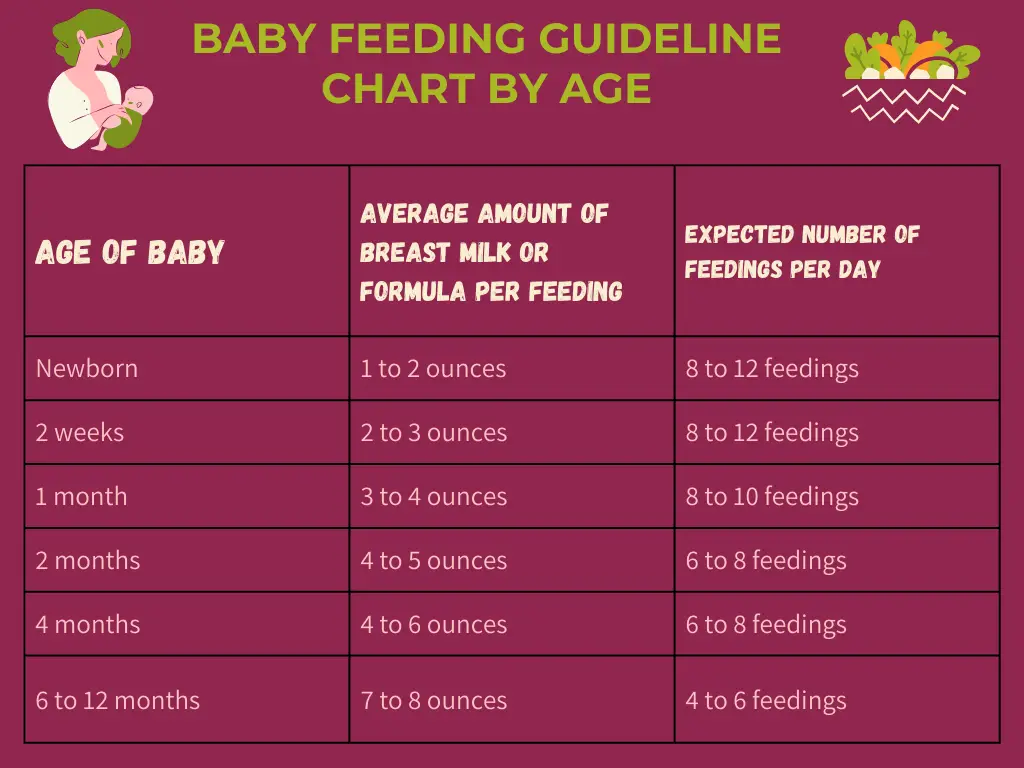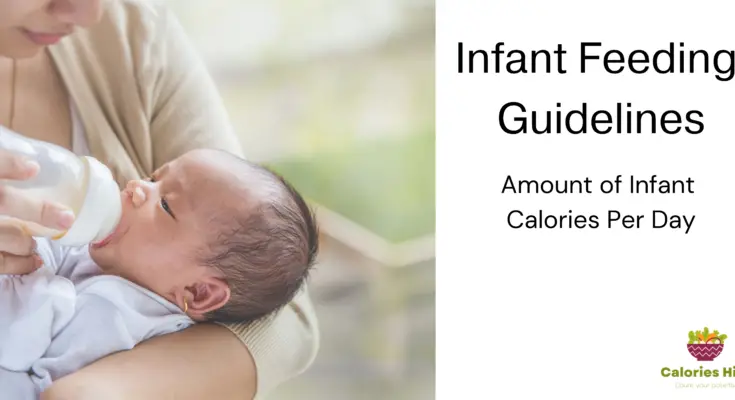One of the most common questions is asked Is there a recommended amount of Infant Feeding Guidelines We get it – the world of infant nutrition can be a bit of a puzzle.
The number of calories an infant needs per day depends on their age, weight, and activity level. In general, infants need about 100-120 calories per kilogram of body weight per day. So, a 3-month-old infant who weighs 5 kilograms would need about 500-600 calories per day.
NOTE: It is important to note that these are just general guidelines. The actual calorie needs of an infant may vary depending on their circumstances. For example, a very active infant may need more calories than a less active infant.
In this article, we will discuss your little one’s calorie needs and offer insights into meeting their nutritional needs.
Infant Feeding Guidelines How to Determine?
Nutrition plays a pivotal role in the growth and development of infants, shaping their physical and cognitive progress during the critical early stages of life. One of the fundamental aspects of infant nutrition is understanding their daily infant calorie needs.
It is essential to provide the right balance of calories to support healthy growth. While the caloric requirement for infants’ calories can vary depending on factors such as:
Age: As your baby grows older, they not only get taller but also becomes champions of playtime and exploration. The more they roam, the more energy they need. It’s like leveling up in a video game – with each stage, they require more fuel to conquer new challenges.
Weight: Just like a bigger car needs more gas to go the distance, a bigger baby needs more calories to fuel their journey. It’s simple physics – more body mass means more energy is required to power all those tiny systems working in harmony.
Metabolic Rate: Have you ever wondered why someone you know doesn’t gain weight regardless of how many calories they eat? is it no magic, just a good metabolism Just like that your baby’s metabolic rate refers to how many calories he needs to maintain his vital functions, such as digesting food, breathing, and functioning correctly. However, every baby’s metabolic rate is different. Faster metabolism needs more calories.
Physical Activity: Crawling, Wiggling, and Conquering new milestones. These pint-sized activities are like turbo boosts for calorie burning. Your baby needs extra calories to power these high-octane adventures. From those adorable first steps to crawling marathons, active babies demand a bit more in the calorie department.
NOTE: If you are concerned about your infant’s calorie intake, talk to your doctor. They can help you determine how many calories your infant needs and make sure they are getting enough.

Infant Feeding Guidelines Starting from 0-12 Months
The caloric needs of infants change significantly during their first year of life. Newborns have relatively low energy needs due to their small size and limited physical activity. Here is a breakdown of the calorie requirements of infants between 0-3 years of age
Did you know? During an infant’s first year of life, breast milk and formula are the primary sources of nutrition. According to the American Academy of Pediatrics (AAP), it is to intake t every two to three hours, and they drink 1 to 2 ounces of breastmilk per feeding. When your baby reaches 2 weeks old, this amount increases to 2 to 3 ounces per feeding.
Infant Feeding Guideline 1-3 Months
In the initial few months, breast milk or formula milk is the primary source of nutrition, providing the necessary calories for growth. On average, during the first month of life, a newborn requires about 110-120 calories per kilogram of body weight per day. This translates to approximately 400-500 calories per day for an average 3.5 kg (7.7 lbs) newborn.
Boys
- 1-3 months – 472-572 calories per day
Girls
- 1-3 months – 438-521 calories per day
To make sure that your infant meets their calorie needs, you can feed your infant whenever they are hungry or full. Make sure you offer your infant a variety of healthy foods so that they will be getting all the nutrients they need. Breastfeed or formula feed your infant for as long as possible Breast milk and formula are both excellent sources of calories and nutrients for infants.
NOTE: Feed your infant on demand. Infants will let you know when they are hungry and full.
Breastfeed or formula Which is better?
Breast milk is a remarkable natural source of nutrition for infants. It not only provides calories but also contains essential nutrients, antibodies, and enzymes that support a baby’s overall health.
Moreover, Breastfeeding can help lower the risk of postpartum depression in mothers and help mothers and babies bond.The caloric content of breast milk can vary, but it generally contains around 20 calories per ounce (30 mL).
The formula is a safe and healthy alternative to breast milk. It can be used to supplement breastfeeding or to feed babies who are not able to breastfeed. For formula-fed infants, the caloric content of formula can be different based on the brand and type.
Most infant formulas contain about 20 calories per ounce as well. It’s important to note that while formula can provide adequate nutrition, breast milk is uniquely tailored to a baby’s needs and offers numerous benefits.
NOTE: Mothers of 0-12 months – encourage breastfeeding exclusively until 6 months of age and continue to 12 months or beyond, after introduction of solid foods. Offer new foods repeatedly and avoid sugar sweetened beverages and snack foods.
Ultimately, the decision of whether to breastfeed or formula feed is a personal one. There is no right or wrong answer. The best way to feed your infant is the way that works best for you and your baby.
Infant Feeding Guideline 4-6 Months
Boy 4-6 months – 548-645 calories per day
Girl 4-6 months – 508-593 calories per day
Around the age of four to six months, infants begin to show signs of readiness for solid foods. The introduction of complementary foods is a crucial phase, as it marks a transition from exclusive milk feeding to a more diverse diet. Solid foods provide additional calories and a broader range of nutrients. However, breast milk or formula should remain the primary source of nutrition during the first year, with solid foods gradually supplementing their diet.
At this stage, your baby’s digestive system is becoming more ready to handle different textures and flavors. Here are some appropriate and nutritious options for their first adventures into solids:
| Single-Ingredient Purees | Start with single-ingredient purees made from easy-to-digest fruits and vegetables. Common choices include mashed bananas, cooked and pureed sweet potatoes, and pureed apples or pears. These foods offer essential vitamins, minerals, and natural sweetness. |
| Rice Cereal | Fortified rice cereal is a popular option for its mild taste and smooth texture. Mix it with breast milk or formula to create a creamy consistency that’s easy for your baby to swallow. Gradually adjust the thickness to match their comfort level. |
| Avocado | Avocado is a nutrient-rich food with healthy fats that support brain development. Its creamy texture makes it a great choice for introducing new textures to your baby. |
| Pea Puree | Cooked and pureed peas provide a source of plant-based protein and dietary fiber. They also introduce a slightly thicker texture to help your baby get accustomed to different mouthfeel sensations. |
| Carrot Puree | Cooked and blended carrots offer a slightly sweet and vibrant option packed with beta-carotene, an essential nutrient for eye health. |
| Butternut Squash Puree | This smooth and slightly sweet puree is rich in vitamins and minerals, making it a nourishing choice for your baby. |
| Oatmeal Cereal | Oatmeal is another cereal option that can be introduced, offering fiber and a different texture for your baby to explore. |
| Peach Puree: | Mashed or pureed peaches provide a burst of natural sweetness and vitamin C. Make sure to peel and pit the peach before preparing it. |
When introducing solids, keep these tips in mind:
- Texture: Start with smooth, runny purees and gradually move towards slightly thicker textures as your baby gets used to eating. This helps them transition to more complex textures over time.
- One Food at a Time: Introduce new foods one at a time, with a gap of a few days between each new introduction. This allows you to identify any potential allergies or sensitivities.
- Sitting Position: Feed your baby while they are sitting upright, either in a high chair or supported on your lap. This minimizes the risk of choking.
- Reaction Monitoring: Watch for any allergic reactions or adverse effects after introducing a new food. Common signs of allergies include rash, diarrhea, vomiting, or unusual fussiness.
- Breast Milk or Formula: Continue to offer breast milk or formula as the primary source of nutrition. Solids are meant to complement, not replace, milk feeds during the first year.
Remember that every baby is unique, and their readiness for solids may vary. Consult your pediatrician before introducing solid foods to ensure it aligns with your baby’s developmental stage and individual needs.
Infant Feeding Guideline 7-12 Months
As your infant continues to grow and develop, their journey into solid foods becomes even more exciting and diverse. Between the ages of 7 to 9 months, your baby is likely becoming more skilled at handling different textures and flavors. You can now introduce a wider range of foods that offer greater complexity in taste and nutritional value. Here are some nutritious and appropriate options for this stage:
Boy 7-12 months – 793-844 calories per day
Girl 7-12 months – 717-768 calories per day
| Mashed Fruits | Expand your baby’s palate with a variety of mashed fruits. Try introducing options like mashed mango, papaya, or melon. These fruits provide natural sweetness and vitamins. |
| Soft Cooked Vegetables | Cooked and softened vegetables like peas, carrots, sweet potatoes, and zucchini can be mashed or cut into small, manageable pieces. These veggies offer essential nutrients and introduce more varied textures. |
| Poultry and Meat | You can start introducing well-cooked and finely shredded or minced poultry (like chicken or turkey) and lean meats (such as beef or pork). These are excellent sources of protein, iron, and other important nutrients. |
| Yogurt | Yogurt: Plain, full-fat yogurt is a great source of calcium and probiotics for your baby’s growing digestive system. Avoid flavored yogurts with added sugars. |
| Cheese | Cheese: Offer small pieces of soft cheese, such as mild cheddar or mozzarella, cut into appropriate bite-sized portions. Cheese is a good source of calcium and healthy fats. |
| Whole Grains | Whole Grain Cereals: Introduce a variety of whole grain cereals like oatmeal, quinoa, or barley. These grains provide dietary fiber and energy for your baby’s active exploration. |
| Egg Yolks | Egg Yolks: You can offer cooked and mashed egg yolks, as they are a rich source of nutrients including iron and healthy fats. Ensure the egg is fully cooked and well-mashed to prevent choking hazards. |
| Legumes | Mashed or finely chopped legumes like lentils, chickpeas, and black beans provide protein, fiber, and other important nutrients. |
| Finger Foods | At this stage, your baby might be ready to explore finger foods. Offer soft and appropriately-sized pieces of fruits, vegetables, and cooked pasta for them to practice self-feeding. |
| Combination Meals | You can start creating simple combination meals by mixing and matching different ingredients. For instance, you can combine finely mashed chicken with cooked vegetables or mix yogurt with fruit puree. |
Remember these key points:
Textures: Continue to gradually increase the texture complexity as your baby becomes more comfortable with chewing and swallowing. Progress from smooth purees to soft, mashed, and finely chopped foods.
Allergens: If your baby has been tolerating different foods well, you can start introducing common allergens like peanut butter (ensure it’s thinned with water or breast milk) and wheat products.
Variety: Aim for a diverse diet that includes different food groups to provide a well-rounded nutritional intake.
Supervision: Always supervise your baby during meal times to prevent choking hazards. Cut foods into appropriate sizes and shapes to ensure safe eating.
Remember! Consult with your pediatrician before introducing new foods to ensure that your baby’s diet aligns with their developmental needs and any specific considerations they may have. Enjoy this stage of discovering flavors, textures, and watching your baby’s eating skills blossom!
Before introducing new foods, consult your pediatrician. They can offer personalized advice and ensure your baby’s nutritional needs are being met. Enjoy this phase of culinary exploration with your little one!
Nutrients Your Infant Needs
Now that we’ve tackled the importance of your little one’s calorie intake, let’s look into who is responsible for those precious calories. Carbs, proteins, and fats – these three are the ultimate calorie contributors that power your baby’s growth journey. We are going to break down each player and understand how they’re fueling your baby’s adventures!
Carbs
Carbohydrates are the superheroes of energy, providing the oomph your baby needs to conquer their daily milestones. You won’t believe it, but a single cup of breast milk boasts a whopping 17 grams of carbs – that’s even more than a slice of bread! These energy-packed gems not only fuel growth but also help transform proteins into the building blocks of new tissues. It’s like a power-up for your baby’s development journey.
Proteins
Proteins aren’t just essential, they’re the architects behind your baby’s growth blueprint. They’re the magical ingredient that builds, repairs, and maintains new tissues throughout your baby’s body. Imagine those bright eyes, tiny muscles, and even the heart that beats with love – proteins are the masterminds behind it all. They’re also the creators of hormones, antibodies, and enzymes that ensure your baby’s development takes center stage.
Fat
Fat might have a reputation, but it’s a true multi-tasker in your baby’s nutrition show. Did you know that nearly half of the energy your baby gets from breast milk or formula comes from fat? It’s like the secret sauce that adds flavor to those chubby cheeks. But that’s not all – fat is a hero in disguise. It’s the key to unlocking the treasure trove of vitamins A, D, E, and K. Plus, it paves the way for healthy brain development, strong skin and hair, and a resistance shield against infections.
The Recipe for Nutritional Success
So, fellow caregivers, remember that nourishing your baby isn’t just about calories; it’s about embracing the dynamic trio of carbs, proteins, and fats. It’s about providing the best possible nutrients to fuel their journey into the world, one chubby cheek and curious giggle at a time.
Safety: Always supervise meal times and offer foods appropriate for your baby’s stage of development to prevent choking.
CONCLUSION
There are a few signs that can help you tell if your baby is eating enough. These include wet diapers, poops, weight gain, satisfaction after feedings, and sucking. If you are concerned that your baby is not eating enough, talk to your doctor. They can help you assess your baby’s feeding and growth and make sure they are getting the nutrients they need.
It is important to remember that the amount of food that a baby needs to eat will vary depending on their age, weight, and activity level. It is also normal for babies to have periods of fussiness or decreased appetite. This is usually due to a growth spurt or a developmental milestone.
If you are breastfeeding, make sure that your baby is latching on properly. A poor latch can make it difficult for your baby to get enough milk. If you are formula feeding, make sure that you are using the correct amount of formula. Too much formula can make your baby feel full and prevent them from eating enough.
By following these tips, you can help ensure that your baby is getting the nutrients they need to grow and develop health.
FAQs
Q.1 What are the guidelines for Infant Formula Feeding?
A.1 This is a general guide of how much infant formula your baby might need:
- 5 days to 3 months old: 150mL per kilogram of body weight each day.
- 3 to 6 months old: 120mL per kilogram of body weight each day.
- 6 to 12 months old: 100mL per kilogram of body weight each day. Babies at this age also eat complementary foods.
Q.2 What are the standards for Infant Feeding?
A.2 At least 8-12 feeds in each 24 hour period. If bottle feeding, the mother will be encouraged to practice responsive parenting by responding to baby’s cues, give the majority of feeds herself, hold her baby close and pace the feeds.
Q.3 What are the appropriate Infant Feeding practices?





2 Comments on “Infant Feeding Guidelines – Calorie Intake 0-12 Months”